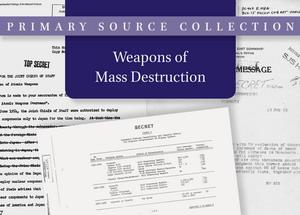Inside US Intelligence: Alex Wellerstein on Secrets, Classified Documents and Forgeries
Previously classified documents on US intelligence activities following World War II have begun to emerge from decades of secrecy. Alex Wellerstein, who studies the history of nuclear weapons, shares the fascinating insights he has uncovered through these unique primary sources.
The activities of US Intelligence are often shrouded in mystery. However, as documents become declassified, new narratives and clearer perspectives start to emerge. De Gruyter Brill’s US Intel collections provide researchers with access to thousands of digitized documents that can shine light on this intriguing aspect of history.
The extensive collections are made up of previously classified primary sources related to the intelligence community’s post Word War II activities in Asia (1945-1991), Europe (1945-1995) and the Middle East (1945-2009). Meanwhile, the Weapons of Mass Destruction (WMD) Collection shows how the US built up a vast stockpile of nuclear, chemical and biological weapons, and reveals the international impact this had.
Alex Wellerstein is a historian of nuclear weapons and a professor at the Stevens Institute of Technology in Hoboken, New Jersey. He drew extensively on the WMD collection while researching his upcoming book on President Truman-era nuclear weapons policies, The Most Awful Responsibility: Truman and the Secret Struggle for Control of the Atomic Age.

Here, he explains how the collection supported his work and how his intimate knowledge of documents from the era even allowed him to uncover a forgery.
De Gruyter Brill: What brought you to the US Intelligence and WMD collections?
Alex Wellerstein: I’m a historian who uses lots of online databases and I’m also a database programmer. My whole career has been very PDF-heavy, lots of digital documents. I try to locate every database that might house things that are useful to me and to find everything in there that I might want to look at. That’s what brought me to the collections.
DGB: Why was the WMD collection especially valuable to you?
AW: It’s been very carefully curated and has lots of obscure documents. Some are documents other historians have cited, but I always like to go back to the originals. Fresh eyes see different things. My strategy is to see as many documents as possible. An individual document in isolation is often hard to interpret, you need to see all the other things around it.

DGB: What types of documents are in the collection?
AW: Many things: reports, memos, letters, commander’s diaries. These are very valuable, though you have to read between the lines and triangulate because they’re sometimes a little cryptic, deliberately so. Also, cables, some CIA assessments and public statements to Congress, transcripts of meetings. They are pulled from a bunch of different sources, it’s much more convenient than tracking things down individually.
DGB: You also found a forged document. How did you discover it?
AW: I just stumbled across it and immediately realized it was something weird. You get a sense of what documents look like and your pattern matching is good at spotting strange things. In this case, it was a document which closely resembled a real one — a strike order for atomic bombs from July 25th 1945, which I know very well. But the forgery was describing the possibility of nuclear weapon use earlier than they had them, so we know that didn’t happen. What I found after digging around was that it was probably made for a game; nobody was ever trying to pass it off as real.
DGB: How are these historical documents relevant to the world we live in today?
AW: Many policies that got put in place then are still in place now. This big one — that the US president is the only person who can decide to use nuclear weapons — gets created by Truman in the 1940s for different reasons than we might imagine; it was about keeping the military from using the weapons. In my book, I show that a lot of systems that exist now do so because of very specific circumstances from 80 years ago; specific people with specific fears. They are not necessarily the most logical or ideal option now.
Check out the primary source collection
[Title image by Michail_Petrov-96/iStock/Getty Images Plus]
